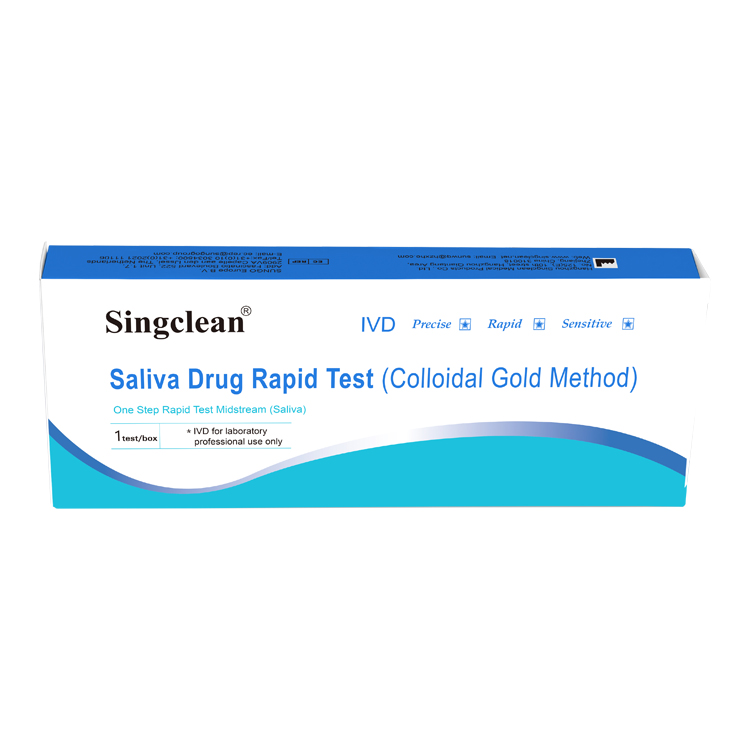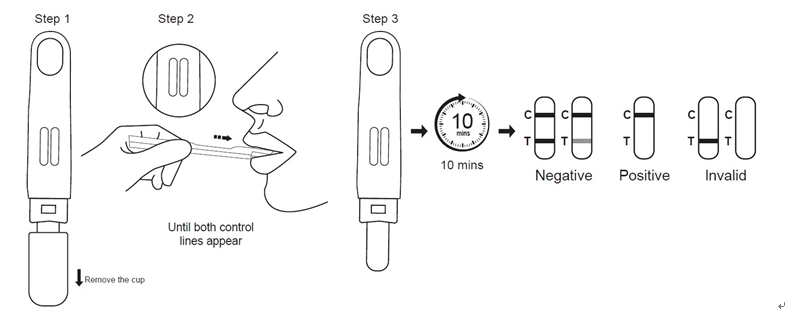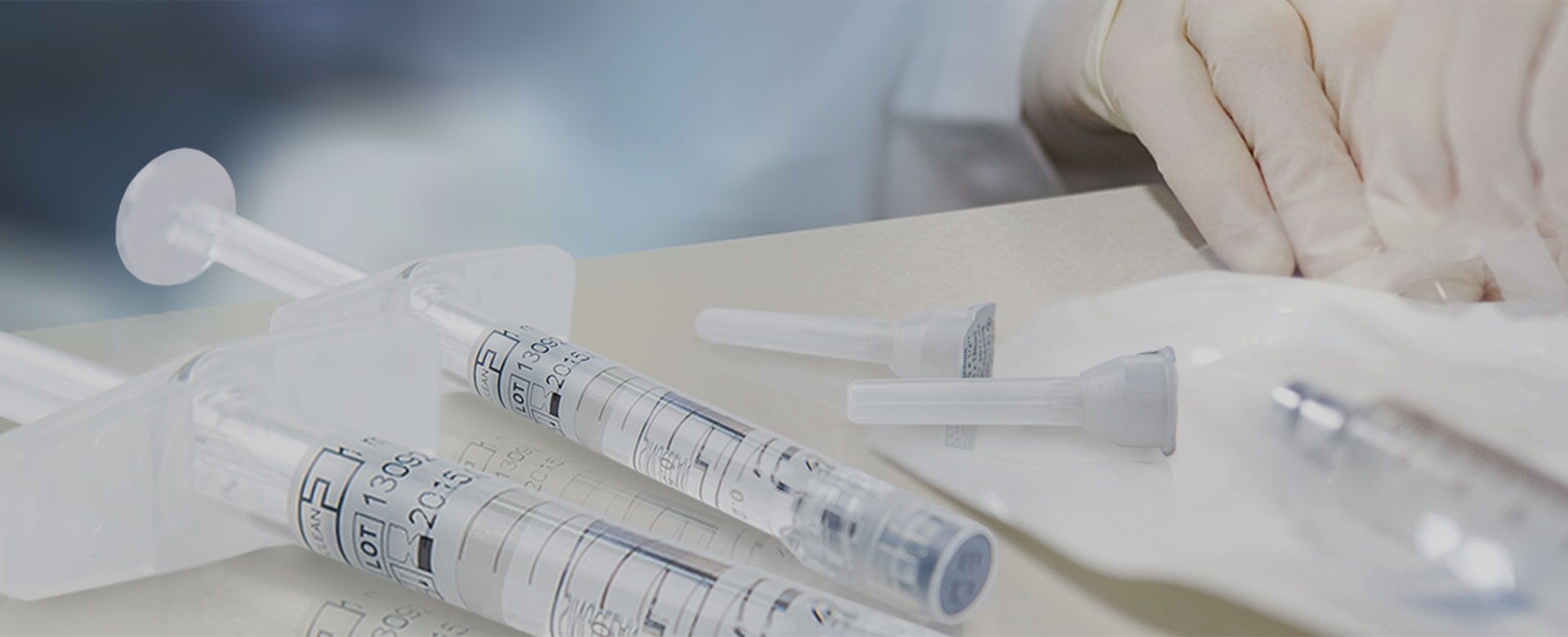
Instructions For Use
Specimen: Saliva
IVD for laboratory professional use only
CE
Instructions for use for testing of any combination of the following drugs: Amphetamine (AMP), Cocaine (COC), Marijuana (THC), Methamphetamine (MET), Opiates (OPI), Benzodiazepines (BZO), Barbiturates (BAR) , Buprenorphine (BUP) , Ketamine (KET) , Methadone (MTD) , Methylenedioxymethamphetamine (MDMA) , Oxycodone (OXY) , Phencyclidine (PCP) , Propoxyphene (PPX) , K2, Alcohol(ALC)
INTENDED USE
The Saliva Drug Rapid Test (Colloidal Gold Method) is a lateral flow chromatographic immunoassay for the qualitative detection of Amphetamine, Cocaine, Marijuana, Methamphetamine, Opiates, Benzodiazepines, Barbiturates , Buprenorphine, Ketamine, Methadone,Methylenedioxymethamphetamine,Oxycodone,Phencyclidine,Propoxyphen, K2, Alcohol and their metabolites in saliva at the following cut-off concentrations. The detection window when drugs can be detected in saliva specimens using this test is also indicated.

This assay provides only a qualitative, preliminary analytical test result. A more specific alternate chemical method must be used in order to obtain a confirmed analytical result. Gas chromatography/mass spectrometry (GC/MS) or Liquid Chromatography/mass spectrometry (LC/MS) are the preferred confirmatory methods. Clinical consideration and professional judgment should be applied to any drug of abuse test result, particularly when preliminary positive results are used.
PRINCIPLE
The Saliva Drug Rapid Test (Colloidal Gold Method) is an immunoassay based on the principle of competitive binding. Drugs that may be present in the saliva specimen compete against their respective drug conjugate for binding sites on their specific antibody.
During testing, a portion of the saliva specimen migrates upward by capillary action. If the drug or drug metabolite concentration in the specimen is below the cut-off level, the anti-drug antibodies in colloidal gold particles will bind to the drug antigens coated in the test line of the nitrocellulose membrane to form a T line which indicates a negative result. If the concentration of drug in the saliva specimen is above the cut-off level, it will bind with antibodies conjugated with colloidal gold particles, so that no T line will be developed in the test region, which indicates a positive result.To serve as a procedural control, a colored line will always appear at the control line region, indicating that proper volume of specimen has been added and membrane wicking has occurred.
Alcohol Test: A pad coated with enzymes, turns to color shades of green and blue when contact with alcohol in the oral fluids. The alcohol pad employs a solid phase chemistry that uses the following highly specific enzymatic reaction:

During testing, oral fluid is collected on the alcohol pad and saturates the alcohol pad. If no alcohol is present in the oral fluid, the alcohol pad remains colorless (remains white or cream color) because there is no alcohol in the oral fluid to react with enzymes to start the color reaction. If alcohol is present in the oral fluid, the alcohol pad changes to green or blue color because the alcohol reacts with alcohol oxidaze to produce aldehyde and peroxide. The peroxide reacts with peroxidase in the presence of hydrogen donor to produce a blue color. Therefore, the presence of green to blue color at the alcohol pad window indicates a presumptive positive result for alcohol.
MATERIALS PROVIDED
Test midstream/Test Cube/Test cassette
Saliva Collector
Instructions For Use
MATERIALS REQUIRED BUT NOT PROVIDED
Timer
PRECAUTIONS
•For in vitro diagnostic use only.
•Do not use after the expiration date indicated on the package. Do not use the test if its foil pouch is damaged. Do not reuse tests.
•All specimens should be considered potentially hazardous and handle in the same way as an infectious material.
•Avoid cross-contamination of specimens by using a new sponge collector for each specimen obtained.
•Read the entire procedure carefully prior to performing any tests.
•The used testing materials should be discarded in accordance with local, state and/or federal regulations.
•Any serious incident that has occurred in relation to the device should be reported to the manufacturer and the competent authority of the Member State.
STORAGE AND STABILITY
•Store in the sealed pouch at 2℃ to 30℃.
•The test is stable through the expiration date printed on the sealed pouch.
•The test must remain in the sealed pouch until use.
•After opening the sealed pouch, use the test as soon as possible within 60 minutes.
•Do not freeze.
•Do not use beyond the expiration date.
SPECIMEN COLLECTION AND STORAGE
The saliva specimen should be collected using the collector provided with the kit. Follow the detailed Directions for Use below. No other collection devices should be used with this assay. Oral fluid collected at any time of the day may be used.
Collect the saliva sample using the sponge collection vial provided, Instruct the donor to not place anything in the mouth including food, drink, gum, or tobacco products for at 10 minutes prior to collection.
PROCEDURE
Allow the kit to equilibrate to room temperature prior to testing
Test midstream
1. Remove the test midstream from the foil pouch by tearing at the notch.
2. Remove the midstream cap, insert the sponge top into the mouth. Actively swab the inside of the mouth and tongue to collect saliva until the control line appears, then immediately lay the test kit on a flat surface.
3. Read the drug test results at 10 minutes.
Read the alcohol test result at 2 to 5 minutes. (If alcohol is included)

Test Cube
1. Remove the test cube and the sponge collector from the foil pouch by tearing at the notch. Place the test cube upright on a level surface.
2. Put the sponge end of the collector in your mouth to collect the saliva sample until the sponge is fully saturated.
3. Open the test cube and place the fully saturated sponge collector inside the test cube. Press the sponge collector down firmly until it reaches the bottom of the test cube, then close the cube lid tightly while compressing the collector. Keep test cube upright on flat surface. Make sure the sponge collector is inserted vertically and the handle of collector is put into the clamp.
4. Interpreting Drug Test Results: Read results at 10 minutes.

Test cassette
1.Remove sponge from Saliva Collector.
2.Insert the sponge end of the collector into the mouth. Actively swab the inside of the mouth and tongue to collect saliva for 3 min until the sponge becomes fully saturated. No hard spots should be felt on the sponge when saturated.
3.Open the top of the collection chamber then remove the saturated salvia collector from the mouth and place it into the collection chamber Press the sponge fully against the strainer to extract as much saliva possible into the collection chamber.
4.Unscrew the collector cap and add 3d saliva to the sampling hole.Read the drug test results at 10 minutes. Read the alcohol test result at 2 to 5 minutes. (If alcohol is included)

INTERPRETATION OF RESULTS
NEGATIVE:
A color band is visible in the control region(C) and the appropriate test region. It indicates that the concentration of the corresponding drug of the specific test region is zero or below the detection limit of the test.
POSITIVE:
A color band is visible in the control region(C). No color band appears in the appropriate test region (T). It indicates a positive result for the corresponding drug of that special test zone.
INVALID:
A color band is not visible in the control region(C), the test is invalid. Another test should be run to re-evaluate the specimen. If test still fails, please contact the distributor or manufacturer with the lot number.
Drug Test Results

NOTE: There is no meaning attributed to line color intensity or width.
Alcohol Test Results
Alcohol Negative:
The alcohol pad shows no color change (remains white or cream color), it should be interpreted as a negative result (no alcohol present). A result where the outer edges of the alcohol pad produces a slight color but the majority of the pad remains colorless should be repeated to ensure complete saturation of the alcohol pad with oral fluid. If the second result is the same, the results should be interpreted as negative (no alcohol present).
Alcohol Presumptive Positive:
The Alcohol test produces a color change to green to blue in the presence of salivary alcohol 0.02 % B.A.C. or higher. At higher alcohol concentration near 0.30% B.A.C., the color may change to a dark blue-gray.

QUALITY CONTROL
Though there is an internal procedural control line in the test device of Control Region (C), the use of external controls is strongly recommended as good laboratory testing practice to confirm the test procedure and to verify proper test performance. Positive and negative control should give the expected results. When testing the positive and negative control, the same assay procedure should be adopted.
LIMITATIONS
· The test provides only a qualitative, preliminary analytical result. A secondary analytical method must be used to obtain a confirmatory result. Liquid chromatography/mass spectrometry (LC/MS) is the preferred confirmatory method.
· A positive test result does not indicate the concentration of drug in specimen or the route of administration.
· A negative result may not necessarily indicate a drug-free specimen. Drug may be present in the specimen below the cut-off level of the assay.




